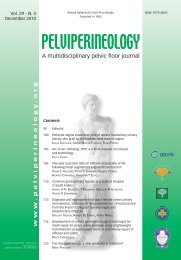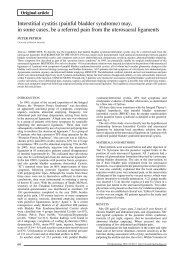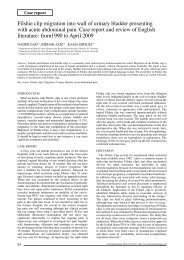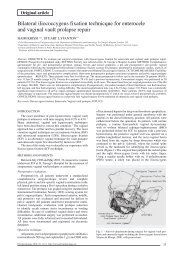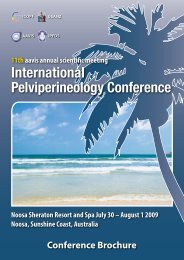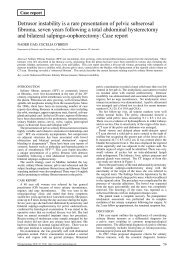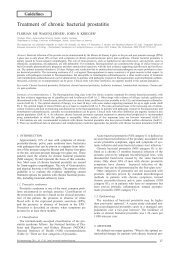This Issue Complete PDF - Pelviperineology
This Issue Complete PDF - Pelviperineology
This Issue Complete PDF - Pelviperineology
Create successful ePaper yourself
Turn your PDF publications into a flip-book with our unique Google optimized e-Paper software.
Pelvic Floor Digest<br />
Mixed urinary incontinence: continuing to confound? Hockey J. Curr Opin Obstet Gynecol. 2007;19:521. Mixed incontinence is a complex<br />
clinical problem for urogynaecologists and generalists alike, as research for new treatments tend to focus on single-symptom groups. Those<br />
with mixed symptoms form a diverse group, which is difficult to study precisely. Recent studies, however, have aimed to classify the subgroups<br />
into predominant types to determine the response to treatment with greater accuracy.<br />
Transobturator tapes for stress urinary incontinence: results of the Austrian registry. Tamussino K, Hanzal E, Kolle D et al. Am J Obstet<br />
Gynecol. 2007;197:634. Data on a total of 2543 operations with 11 different tape systems were collected. Intraoperative complications were<br />
noted for 120 procedures (4.7%): increased bleeding, vaginal, bladder and urethral perforations. Reoperations attributable to the tape procedure<br />
were reported for 57 patients (24 tapes cut or loosened for voiding dysfunction, 11 vaginal erosions, 7 abscesses with erosions). Significant<br />
postoperative pain was reported for 12 patients (0.5%).<br />
National audit of continence care for older people: management of urinary incontinence. Wagg A, Potter J, Peel P et al. Age Ageing. 2007<br />
Nov 21; epub. A national audit was conducted across England, Wales and Northern Ireland. The results indicate that assessment and care by<br />
professionals directly looking after the older person were often lacking. There is an urgent need to re-establish the fundamentals of continence<br />
care into the practice of medical and nursing staff and action needs to be taken with regard to the establishment of truly integrated, quality<br />
services in this neglected area of practice.<br />
The inside-out trans-obturator sling: a novel surgical technique for the treatment of male urinary incontinence. de Leval J, Waltregny D.<br />
Eur Urol. 2007 Nov 20; epub. A new polypropylene sling procedure for treating stress urinary incontinence (SUI) after radical prostatectomy<br />
(RP) is pulled for compressing the bulbar urethra upward and tied to each other across the midline. Patients with detrusor overactivity are<br />
excluded. At 6 months 45% patients were cured and 40% improved (1pad/d), so this procedure appears to be safe and efficient at short term.<br />
Further studies are warranted to determine long-term outcome.<br />
Long-term follow-up of a transvaginal Burch urethropexy for stress urinary incontinence. Rardin CR, Sung VW, Hampton BS et al. Am<br />
J Obstet Gynecol. 2007;197:656. A vaginal Burch urethropexy for urodynamic stress urinary incontinence with urethral hypermobility was<br />
performed in 66 women using a suture carrier device. Concurrent prolapse repairs were performed as indicated. Mean follow-up time was 20.9<br />
+/- 18.9 months. Objective failure was observed in 16 patients (24.2%). Subjective failure was reported by 21.2% of patients, with 50% and<br />
28.8% reporting success and improvement, respectively. Six patients (9%) experienced febrile illness, 4 (6%) intraoperative hemorrhage, 1<br />
pelvic abscess, 12 (18.2%) suture erosion; half required surgical revision or excision. It is concluded that vaginal Burch urethropexy is well<br />
tolerated but is associated with poor long-term success and high suture erosion rates.<br />
Complication rates of tension-free midurethral slings in the treatment of female stress urinary incontinence: a systematic review<br />
and meta-analysis of randomized controlled trials comparing tension-free midurethral tapes to other surgical procedures. Novara G,<br />
Galfano A, Boscolo-Berto R, Secco S, Cavalleri S, Ficarra V, Artibani W. Eur Urol. 2007 Nov 8; epub. To evaluate the complication rates of<br />
tension-free midurethral slings compared with other surgical treatments for stress urinary incontinence a systematic review of the literature<br />
using MEDLINE, EMBASE, and Web of Science identified 33 randomized controlled trials reporting data on complication rates. Tensionfree<br />
slings were followed by lower risk of reoperation compared with Burch colposuspension, whereas pubovaginal sling and tension-free<br />
midurethral slings had similar complication rates. With regards to different tension-free tapes, voiding LUTS and reoperations were more<br />
common after SPARC, whereas bladder perforations, pelvic haematoma, and storage LUTS were less common after transobturator tapes. The<br />
quality of many evaluated studies was limited.<br />
Botulinum toxin A (Botox((R)) intradetrusor injections in adults with neurogenic detrusor overactivity/neurogenic overactive bladder<br />
(NDO/NOAB): a systematic literature review. Karsenty G, Denys P, Amarenco G et al. Eur Urol. 2007 Oct 16; epub. A total of 18 articles<br />
evaluating the efficacy or safety of Botox in patients resistant to antimuscarinic therapy, with or without clean intermittent self-catheterisation<br />
(CIC), were selected. Most of the studies reported a significant improvement in clinical (approximately 40-80% of patients became completely<br />
dry between CICs) as well as urodynamic (in most studies mean maximum detrusor pressure was reduced to



